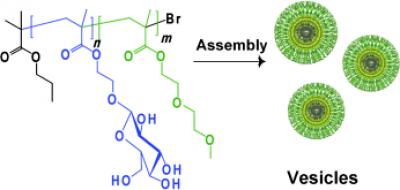Cameron Alexander and George Pasparakis at the University of Nottingham have been able to facilitate a conversation between bacterial cells and artificial polymer vesicles by way of sugar groups on the vesicle surface.
For an organism to develop and function, the individual cells must exchange information, or communicate, with each other. Is it possible to learn their language and "talk to" the cells?
Apparently so. In the journal Angewandte Chemie Alexander and Pasparakis report that this first communication occurred by way of sugar groups on the vesicle surface. The vesicles subsequently transfer information to the cells—in the form of dye molecules.

Complex structures made of many sugar components on the surfaces of cells are the "language" used for processes such as cell recognition, for example, in the differentiation of tissues or the identification of endogenous cells and foreign invaders. Scientists would like to be able to use this glycocode to "address" target cells and to intervene directly in cellular processes to treat diseases or to guide regeneration of damaged tissues.
The British scientists took an interesting route to learn more about the "language" of cells: they constructed vesicles, tiny capsules whose outer shell is made of special polymer building blocks. Their special trick: the polymer chains are equipped with side chains bearing glucose units that wind up being exposed on the vesicle surface.
The researchers brought the vesicles together with bacteria that have glucose-binding proteins on their surface. The behavior of the bacteria varies depending on the polymer's composition and the size of the vesicles. Among the bacteria were some individuals that enter into very strong bonds with large vesicles. These associated bacteria are then in a position to receive molecular "information" from the vesicles: dye molecules that were previously placed in the vesicles transferred specifically into the interior of these bacteria.
"Our vesicles can be viewed as simple replicas of living cells," says Alexander, "that can communicate with real cells by way of the glycocode as well as through signal molecules inside the vesicles." Possible applications include drug transporters that deliver their cargo to specific target cells, or antibiotic transporters that deliver their toxic load exclusively to infectious agents.
Article: Cameron Alexander, University of Nottingham, 'Sweet Talking Double Hydrophilic Block Copolymer Vesicles', Angewandte Chemie International Edition 2008, 47, No. 26, 4847, doi: 10.1002/anie.200801098






Comments